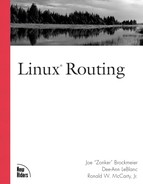Chapter 1. Unicast Protocols

MANY PEOPLE HAVE ONLY A VAGUE IDEA of what routing is and how it works. When the knowledgeable Linux user or novice system administrator thinks of routing, he or she thinks of it in terms of a black box that takes chunks of data, looks at where the data is trying to go, and sends the data happily skipping along in the right direction. This in some ways is not far from the truth.
A router is basically a traffic director.When data travels throughout IP networks, as well as in many other kinds of networks, many different paths are usually available for it to take. Data is bundled in packets—the individual units of data that are sent over an IP network. In general, a router’s job is to choose the current best path for the packet to follow to get to its destination.
Exactly how the router makes this decision is determined by the routing protocol used. Each protocol has its own way of keeping track of what paths are available and which are the most efficient. A unicast routing protocol, in particular, sends information directly to the other routers it is configured to talk to. This class of protocols is a solid choice for networks where bandwidth is at a premium.You must, however, be very careful to ensure that all routing protocols know what routers they are supposed to talk to.
If you want to get right into how to set things up, you can proceed to Chapter 10, “Planning Basic Router Layout and Function” and go from there. However, it’s important that you understand the protocols enough to make an educated choice that best suits your networking needs.
